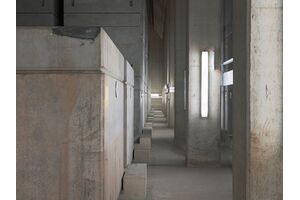Contact
art book cologne GmbH & Co. KG
Deutzer Freiheit 107
50679 Köln
Germany
Opening hours (office and showroom):
Monday to Friday 8 – 17
info@artbookcologne.de
Phone: +49 221 800 80 80
Fax: +49 221 800 80 82
About us
art book cologne, founded by Bernd Detsch in 1997, is a wholesale company and specializes in buying and selling high quality publications in art, art theory, architecture, design, photography, illustrated cultural history and all related subjects internationally. Our team includes specialists in art, culture, music, book trade and media but in spite of our diversity we have one common ground: the enthusiasm for unique art books.
We purchase remaining stocks from museums, publishers and art institutions. We sell these remainders to bookstores, museum shops, and art dealers all over the world.
Michael Collins – The Nuclear Sublime
| Dealer Info | Trade discount 1-2 cps. 30% | 3-5 cps. 35% | 6+ cps. 40% |
| Publisher | RRB Photobooks |
| Year | 2024 |
| Cover | Hardcover with dust jacket |
| Language | English |
| Note | First edition (of 800) |
| ISBN | 978-1-7397023-8-0 |
| Pages | 174 |
| Weight | 1500 g |
| More | |
| Article ID | art-61679 |
Over a period of three years, Michael Collins photographed the interiors of historic and live nuclear reactors and power stations across the UK. Documenting infrastructure spanning a period of seven decades, the photographs in The Nuclear Sublime depict the present state and future of Britain’s nuclear industry— usually hidden from public view.
Collins was granted unprecedented access to Dounreay, Sellafield, Chapelcross, Winfrith, Dungeness, Trawsfynydd, Sizewell A and B, Wylfa and Torness. His large-format photographs show the heart of a live reactor, the storage of nuclear waste, the control rooms and instrumentation, the process of decommissioning old sites, and the insides of fusion “Tokamak” reactors. His photographs depict both the vast scale of the austere chapel-like spaces and intricate details such as rusting control panels with wonky labels, peeling paintwork and miles of wiring. The imagery reveals the contrasts between the monumental size and heights of scientific endeavour with the reality of the sometimes dusty, and worn, outdated equipment and interiors. The images playfully capture the child-like colour palette and pipes alongside abstracted patterns and textures of the intricate infrastructure.
‘A significant proportion of Britain’s retired nuclear power stations are still standing, and because of the issues surrounding their decommissioning (dealing with the radioactive legacy and working in close proximity to it) much of the original infrastructure and equipment
remain almost intact. Contrary to industry’s practice of obliterating its history before it can be monumentalised, a significant element of nuclear energy’s archaeology is still standing.’
The world’s first civil nuclear programme was established in the UK, marked by the opening of Calder Hall, Windscale in 1956. The country currently generates about 15% of its electricity from nuclear sources. It has nine operational nuclear reactors at five locations power stations, and fourteen that are no longer functioning. In July 2023, the government launched Great British Nuclear, with the aim of generating 25% of the UK’s electricity by 2050 through a combination of large nuclear plants and small modular reactors. Most existing capacity is to be retired by the end of the decade.
Michael Collins was born in India in 1961. He has lectured at Harvard, The Royal College of Art and Goldsmiths, and is Visiting Professor of Photography, University of Suffolk. His work has been exhibited internationally including at the British Museum, Barbican Art Centre, SK Stiftung, Cologne, Janet Borden Gallery, New York, RIBA Gallery and City Hall, London; Birmingham City Art Gallery; FFoto Gallery, Cardiff and Impressions Gallery, York. He has been commissioned by the Design Council and Network Rail, The Institution of Chemical Engineers, Birmingham City Council and Potteries Museum and Art Gallery amongst others. His work has been published in Frieze, Granta, Apollo, FT Weekend Magazine, The Guardian, RIBA magazine, Blueprint, Evening Standard, Source, Wallpaper*, and Le Monde amongst others. The Nuclear Sublime is his sixth book.














